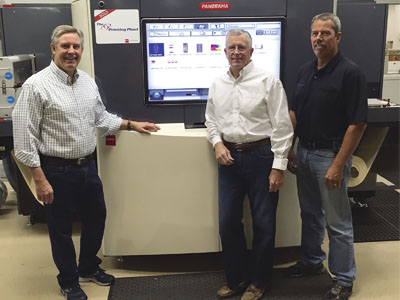(L-R) President Tod Leonard with VP of sales, Brad Schlenk, and plant manager Tim Kraemer of The Printing Plant, with their Nilpeter Panorama
The market is awash with possibilities when it comes to combining printing technologies. Hybrid solutions cover a range of presses, converting machines and modules. Neel Madsen looks at recent developments and installations.
When label presses that combine conventional and digital printing technologies in one machine first came on the market a few years ago, there was some doubt as to the viability of this concept. However, as the number of installations continues to grow, it is becoming clear that they fulfil a need for printers and are finding their niche.
‘It was interesting to see how many digital press vendors are now offering some form of hybrid or inline converting at Labelexpo last year. It really shows how accepted this model has become and indeed recognised as the way forward,’ commented Andy Cook, managing director at FFEI.
Retrofitting an inkjet module onto a conventional press is an alternative road into digital, and again here we are seeing more companies buying into the hybrid idea. There is also the option of building inkjet modules or larger digital print engines into converting equipment. The lines are getting blurred and there will more than likely be even more hybrid technology on show later in the year at Labelexpo in Brussels.
‘The hybrid format is especially suited for applications where there are multiple SKUs per production job and it has opened up new market opportunities for us,’ said Domino’s Philip Easton, who is director of digital printing solutions.
Meeting demand
Nilpeter has made major improvements to the Panorama product line, which was first introduced in 2015. It consists of the DP-3 UV inkjet unit, which can be used as a standalone machine, and converting options that can be added to form an inline configuration. The Danish press manufacturer has completed a re-design of the converting units and press software, and now offers standard, all-round and value-added hybrids, which it says are aimed at meeting a wide and varied spectrum of customer needs and requirements. The inkjet unit uses technology from Screen and is capable of printing at speeds up to 50 m/min in CMYK plus white, at 600 x 600 dpi resolution with Kyocera printheads.
‘Nilpeter has always been an advocate of ‘combination printing’ and has spearheaded technologies that bring together all the different processes for the optimum results. Now, with the improved Panorama, we can deliver highly reliable and productive digital printing and finishing applications, using automation systems, creating results that meet brand-owners’ expectations,’ said Jakob Landberg, sales and marketing director.
The company has reported several sales in the past year. Ikonprint, in Denmark, is producing labels for industrial coating and paints, wine and spirits, as well as cosmetics; Bidone Etichette, in Italy, is printing large quantities of labels, mainly for the wine and food sectors, to both local and international customers; and The Printing Plant, in the US, is serving customers in the grocery, fast food, data capture and automotive industries. Most recently, a number of complete digital hybrid solutions have been sold to an un-named, large European label manufacturer.
Tod Leonard, president of The Printing Plant, stated, ‘The improved speeds and web widths available with the Panorama allowed us to quote and win significant new business. One of our new customers has over 850 prime labels that they are in the process of redesigning, and they specified that we would only be awarded the order if we would commit to printing the labels on the new digital Nilpeter press.’
On the cards
Also introduced at Labelexpo in 2015, MPS has the EF Symjet press, which combines the MPS EF flexo platform with the Domino N610i inkjet engine. The flexo press and digital systems can be used integrated inline, or separately to work offline.
The digital unit uses Kyocera printheads to print a resolution of 600 x 600 dpi, in up to six colours plus white. With a 340 mm web width on the Domino printer and wider web width of 430 mm on the MPS press, converters can run more labels across when running in pure flexo mode and at a higher speed.
The press features workflow integration with a Label Traxx MIS/ERP module, an AVT 100% inspection system and a job memory system. Data from this combined workflow is captured in reports and corrections can be fed back to the press to be implemented automatically during live production.
The first EF Symjet in North America was recently installed at Meyers Label and Card Groups, in Minneapolis, which is a producer of labels, cards, signage and display. ‘We have great confidence in MPS technology and innovation,’ said president Gregg Temple. ‘The addition of the hybrid press to our operation has provided the biggest positive impact on our business that we have seen in the last 10 years. Historically, MPS process stability coupled with operator-friendly innovations has had a major impact on our productivity and delivered the lowest defect percentages in the history of the company.’
MPS expects strong growth in the hybrid market as the need to bridge the gap between digital and flexographic printing increases. Although initially a larger investment, the ongoing ability to exchange print technologies and produce labels in either flexo or digital print, or a combination of both technologies, is a significant long-term advantage of a hybrid press.
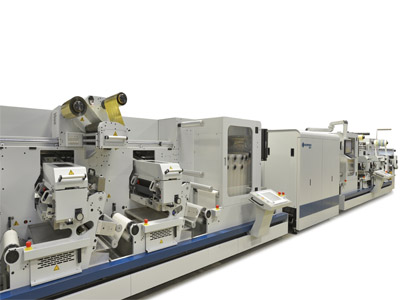
Converting line from ABG with Domino print engine integrated
Domino’s N610i inkjet engine can also be seen as the driving force behind Omet’s JetPlus module, which is sold as part of a hybrid solution. Domino further works with AB Graphic, CEI, Delta ModTech and Gonderflex to integrate it into their offerings, and 13 of these converting hybrid systems have been sold so far. One was to Autajon (Sinel) in Barcelona, which ordered an ABG Digicon 3 with seven-colour UV inkjet printing for the production of high quality labels.
Digital with flexo
Durst turned to Italian flexo press manufacturer Omet when it wanted to develop a hybrid press platform. The result of the new cooperation was first presented at Labelexpo Americas last September. This sees the Tau 330 UV inkjet press surrounded by the Omet XFlex X6 flexo press together producing a modular hybrid system that can be adapted to the user’s needs.
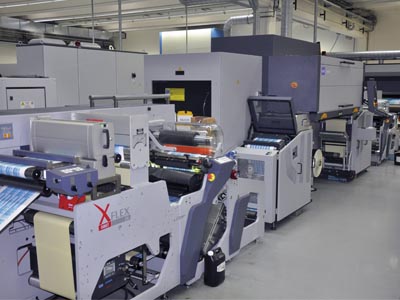
Durst Tau 330 with Omet’s XFlex X6 added
The Tau 330 platform is a UV inkjet label press which features a 330 mm print width, prints in up to seven colours (CMYK with orange, violet and white) at speeds of up to 48 m/min with a maximum print resolution of 720 x 1260 dpi in HD mode. This has been combined with flexo units before and after the inkjet engine for priming, spot colours, coating and varnishing, along with web cleaner, corona treatment, hot air dryer and UV curing. Options include semi-rotary or full rotary die-cutting, cold foiling, screen printing, slitting and matrix removal, amongst others.
The new hybrid configuration promises to expand material flexibility for a vast range of applications and to offer cost savings. It will have its European debut at Interpack, in Düsseldorf, early May before the worldwide introduction later this year.
New capabilities
FFEI has introduced a number of new, application specific features over recent months for the Graphium hybrid press, which was first brought to market back in 2013. One example is a thin film modification kit, which means the press can handle film down to 12 microns.
‘For food and beverage, personal care, household and wine and spirit brands, this opens up promotional print opportunities that simply weren’t cost effective or even possible before, such as medium to long run product variants and promotional packaging with full colour VDP,’ explained managing director Andy Cook. He continued, ‘With this new capability packaging weight and waste can be reduced while maintaining exceptional print quality, ensuring fit-for-purpose products are produced.’
To ensure perfect fit and alignment, Dynamic Sync Technology has been added. This synchronises digital to flexo using standard sync marks, and also dynamically tracks trends within the print run and compensates the digital image for web stretch fluctuations on the fly.
At Labelexpo in September, FFEI will be showcasing its digital inkjet integration capabilities, with its ‘Printbar Uncovered’ system taking centre stage. Mr Cook explained, ‘We want to help OEMs disrupt the labels and packaging market with innovative inkjet solutions – like Graphium. The Print Bar development system is a perfect example – partners have the opportunity to benefit from proven technology and make it their own – embodying their brand values in terms of look and feel, quality, serviceability and support.’
He continued, ‘We have worked closely with many OEM partners translating their market knowledge and brand values into the industrial digital inkjet system they envisaged. Our highly innovative and advanced imaging and digital inkjet technology powers a variety of market-leading products throughout the labels and packaging industry.’
Series production
Following a number of orders from Europe and Australia, Heidelberg and Gallus are now reporting success in the American market for the Gallus Labelfire 340 digital label press.
The press is a joint development by Heidelberg and Gallus, based on Fujifilm inkjet technology. Heidelberg has now started series production of the digital inkjet print engine in Wiesloch-Walldorf, where the company’s entire digital printing portfolio also will be manufactured in the future. The base unit of the press is made by Gallus at its German production site in Langgöns. The system is designed to meet growing demand for the cost-effective production of short, medium and versioned label runs.
Info Label from Clifton Park, in New York, is the first label print shop to install the press in the US. The company’s president, Mark Dufort, saw the first demonstration press at the Digital Label Forum in Heidelberg and then visited Gallus HQ in St Gallen, in Switzerland. ‘By investing in the Labelfire 340, we’re offering our customers outstanding quality combined with shorter delivery times at lower costs,’ he said.
Hub Labels, in Maryland, has also signed up. The company’s first sight of the machine was at Labelexpo Europe in 2015, and a press was delivered a few months later. President Thomas Dahbura said, ‘This is the first digital press I’ve seen that can do exactly what I expect it to. It integrates all steps from the reel to the finished label in a single production pass – whether digital or flexographic printing, cold-foil printing or die-cutting. I was impressed by how much effort Gallus and Heidelberg put into ensuring this system was a success. Although we’ve already seen other presses with an excellent resolution of 600 x 600 dpi, this one is simply unbeatable with its resolution of 1200 x 1200 dpi.’
Modular approach
‘The basic idea of a hybrid press is that it combines the best of both worlds,’ said John Corrall, IIJ’s managing director. ‘You have inkjet to print the parts of the image that need to change regularly, and you have conventional print (typically flexo) to print background parts of the image that only change rarely, or to print large areas of colour that will need a lot of ink. A hybrid press allows the printer to decide for each individual job the most economic way to print it.’
IIJ provides a wide range of inkjet modules for installation onto existing flexo presses, as an alternative to standalone inkjet label presses. These are powered by Konica Minolta technology to offer high uptime and long printhead life. The compact units print full variable images in process colours, black, white, varnish or spot colours, as well as security inks at up to 1200 dpi resolution.
Mr Corrall said, ‘There are a lot of existing very good flexo presses in the world – with a lot of life left in them – and it makes sense to re-use them instead of scrapping them. So our view is that it often makes economic sense to simply add an inkjet module to the customer’s current press. As well as reducing investment cost, it also means finishing doesn’t have to be changed. The operator can continue to slit and die-cut exactly as before. The new investment is only for the inkjet unit. Nothing else need to change.’
But not everyone has existing equipment that can be upgraded. Mr Corrall continued, ‘We are also seeing flexo press providers waking up to this idea. So rather than sell a flexo-only press, they will now offer a flexo press ready-built with a space for an IIJ digital module and dryer. The benefit of this idea over a ready-built hybrid press is flexibility. The conventional press manufacturer will typically be more willing to build a press to the exact requirements of the customer in terms of number of flexo colours, where the inkjet unit sits, speed, print width, material type and finishing.’
He explained that the biggest improvement recently has been in speed. Where a few years ago inkjet speeds were no more than 50 m/m, now 80 m/minute is considered standard for full colour inkjet print, and 160 m/min is feasible (if a little more expensive). Last year IIJ installed a hybrid system to print onto food packaging using low migration ink at 300
m/min and that customer has just ordered two more lines, he concluded.
Focus shows d-Flex hybrid
Under the heading, ‘Innovation and Technology’, Focus Label Machinery held an open day on 1 March at its home in Bingham, near Nottingham, where it showed a number of presses, including the d-Flex hybrid which incorporates an inkjet module from IIJ.
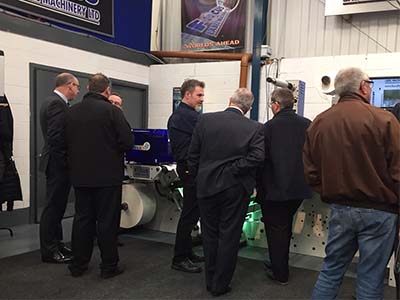
Customers from all over the country were treated to a tour of the manufacturing facilities and demonstrations in the showroom, where the company’s products were shown.
The d-Flex combines inkjet technology with a number of flexo print configurations. James Thomas, business development and marketing manager, explained, ‘This model is ideal for small and medium volume orders, very short runs, just in time printing, multiple SKUs, frequently changed designs and some degree of variability, versioning, repeat jobs or even just batch numbering. This is all feasible with a cost per copy that end users will accept, and it offers our customers the opportunity to expand the portfolio of products they can can offer.’
Key features include mono and four colour printing plus optional white (either via inkjet or flexo), a choice of web widths, UV drying systems and single colour rotary flexo head for pre-coating, printing and over-varnishing, plus inline converting and finishing systems.
Flexo still applies
The US seems to have taken to hybrids like a duck to water. Since the first beta press was installed in December 2013, Mark Andy has sold a large number of its Digital Series, which incorporates an inkjet module into a dedicated print platform with flexo stations, die-cutting station and other modules.
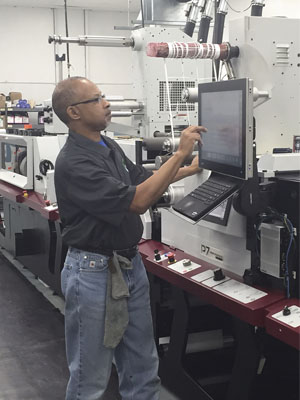
Operator Claude Steele, WS Packaging in Dallas, at work on the Mark Andy Digital Series
WS Packaging Group has worked closely with Mark Andy as an early beta site for the Digital Series hybrid technology for the past three years. The company has 17 facilities throughout North America, and installed a second Digital Series late last year. The new press, custom-configured and installed at its Dallas facility, will augment the growth resulting from its original investment.
The first press is running two 12-hour shifts, seven days per week and supports the company’s growing customer demands for fast response, short lead times, multiple SKUs, variable data printing and versioned graphics. Print runs range from 106 to 2438 metres, with about 25 changeovers in a shift.
‘Mark Andy’s Performance Series is a solid piece of flexo equipment, very accessible, and very easy to operate and get people up to speed on,’ said Ryan Reding, general manager for the Dallas and Phoenix plants. ‘With the Digital Series, all of the things we learned about flexo over the years are still applicable; it’s just from this section to this section we are laying down digital ink.’
The acquisition of a second press was a direct result of the partnership between the two companies. ‘One of the things that is a huge differentiator is the support and service that Mark Andy has provided us,’ said Mr Reding. ‘I have a high level of confidence working with Mark Andy; the fact that they really are supporting us on a constant basis and looking for opportunities for us to improve.’
In agreement
Last year, Wisconson-based Colordyne Technologies entered into an agreement with Mark Andy, which saw the latter become an exclusive distributor of the Colordyne 3600 Series digital print technology incorporated onto its legacy press models in the American market. The 3600 Series Retrofit (also known as the Mark Andy Digital +3600) is a four colour print module, which runs at speeds up to 500 ft/min printing in a resolution of up to 1600 x 1375 dpi.
‘Our 3600 Series will be a great addition to Mark Andy’s line up of digital solutions,’ said Brian Connolly, vice president of sales and marketing. ‘We have always seen a large opportunity to provide production scale digital to the existing install base of narrow web label converters in North America.’
Outside of this agreement, Colordyne has supplied Prairie State Group (PSG) with a 3600 Series retrofit. The module was installed at PSG’s Illinois headquarters, where the company prints pressure-sensitive labels and flexible packaging for the food and beverage, health and beauty, and automotive after-market industries.
PSG chose to retrofit its existing flexo press, adding four-colour digital inkjet capabilities, due to the low cost of entry, minimal disruption to its current business and the ability to use existing tooling and finishing.
Prior to adding digital print capabilities, the company produced more than 150 jobs under 5000 feet every month on its own flexo presses or outsourced to a digital printer. Many of these analogue jobs required longer set-up times than run times.
‘With the growing demand for short run jobs, we knew it was a bigger risk not to go digital,’ said Dan Doherty, executive vice president of operations. ‘Adding the Colordyne 3600 Series Retrofit allows us to transition our existing high-mix, low-volume jobs to the digital press. This opens up the capacity to print hybrid jobs and new product launches, particularly in the test market stage, for our customers.
‘The retrofit is putting us on the map as a digital printer and digital is fast becoming the norm at PSG,’ he continued. ‘Existing work is being done more quickly, it saves money on plates and allows clients to walk into a project without fear of their inventory becoming obsolete.’
Read the full March/April issue here.



